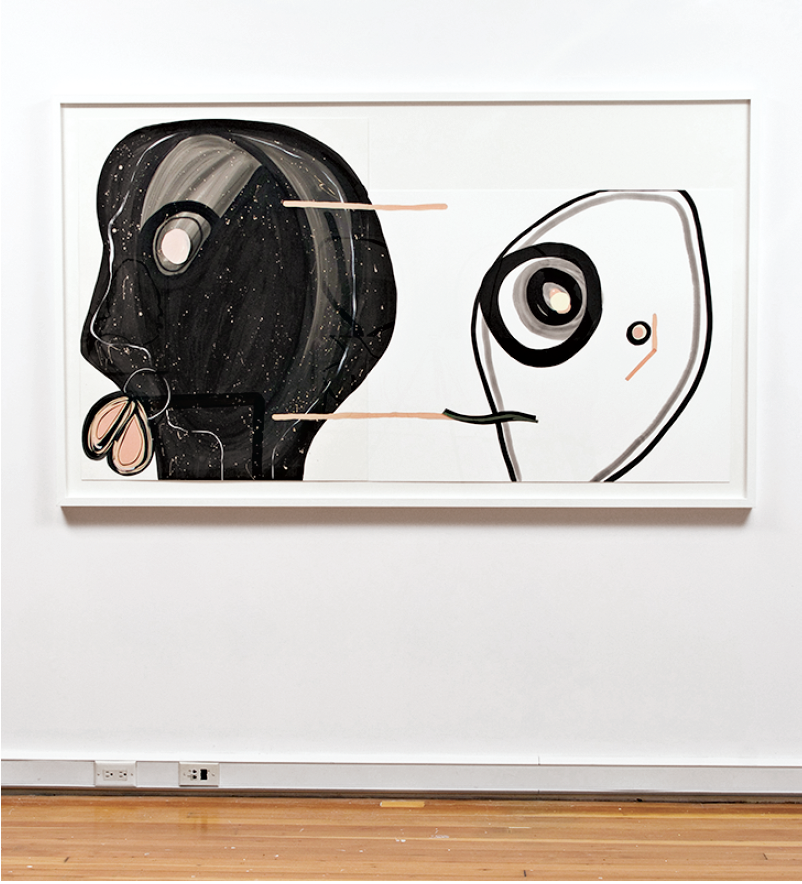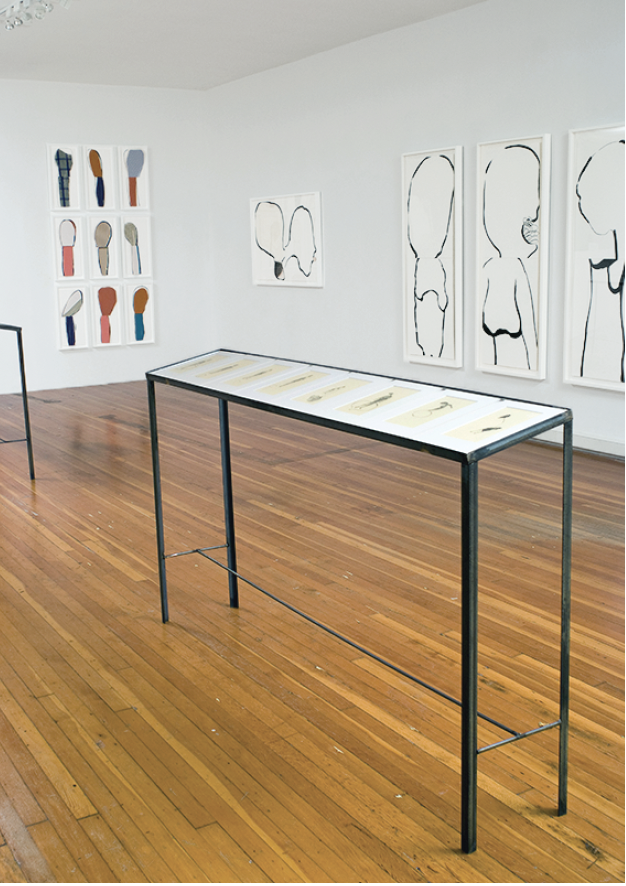Lyse Lemieux
Entering the exhibition “Lyse Lemieux, New Work” the viewer is immediately immersed in an optical rhythm and repetition that draws her toward the work. Moving from one lyrical drawing to the next, the viewer attempts to pinpoint what it is about a particular combination of line quality, ink wash and fabric collage that evokes such humour, absurdity and pathos. These affective qualities are somehow rooted in the artist’s ability to filter highly existential experiences through an intimate response to materials, fashioning subtle shifts of meaning within a repeated vocabulary. There are no linguistic components, and yet the works seem to speak. I am not talking about how some heads seem to have tongues or speech-bubbles emerging from their mouths, but how a finely tuned approach to selecting materials comes to resonate within us as different intonations and accents, some uttered fluidly, some in readymade fashion, some in starts and stops. The works vibrate through textile pattern, gestural line, crinkly glassine, zips of flesh-coloured tape or other collage components. The elements speak to us and to one another.

Lyse Lemieux, Untitled (Faces for March 2), 2011, ink, watercolour, collage and medical tape on archival board, 197.5 x 115.6 cm, framed. Courtesy Republic Gallery, Vancouver. Photographs: Byron Dauncey
The works in this exhibition can be divided into two bodies: a series of large-scale head-torso drawings hung on the wall, and a series of smaller ink drawings titled “LolaBed” placed on custom-made metal table stands. In the “LolaBed” series, 16 drawings were chosen from a series of 130. Two metal table stands contain eight drawings each, assembled according to formal similarity. On one table, spindly ‘stick’ bed drawings dominate, each tilted at a different angle, and on each spindly bed lies a spindly person, with just a slight lump for a head, chest or stomach. An accretion of fragile layers of ink wash constitutes each body-bed formation, like the buildup and erosion of rock over time. Sunk into the mattress, the supine figure has become one with its matter. Although the beds tilt, the figure, Lola, will not slip off. On the other table we find another series of drawings with Lola out of bed. Her presence is more corporeal here, although made of the same marvelous mottled ink. Lines emerge from her head, nose, breast and hand. The tail end of each line is attached to a prosthetic-head in profile. In two drawings the figure has freed herself of the prosthetic threads, and she dances within or around the circumference of the head. Looking at the line of drawings, you begin to see alphabets, or illustrations of choreographed bodily movements: rhythms of breath and body, investigations into an alternate corporeal language. Inspiration for these drawings came from the experience of visiting a friend in her hospital bed. The lines from the figure’s body are the breathing tube that emerged from her nose. So we are witness here to the line that dances and lives (and that helps live), as well as the line that feels fragile and vulnerable.
On the walls are a series of large heads and torsos. Each drawing has a two-part structure. The separation between head (rationality/thinking) and body (corporeality/matter) seems intentional. You think differently about the head versus the body and come to believe that humans think with their heads, subjectively, while the body is largely controlled by the mechanisms of thinking. As a result you respond more objectively to the body. They are both fragile sites of judgment, but they are nonetheless separate in the Western mind. Lemieux acknowledges the persistence of Cartesian dualism while at the same time doing away with it. Head and body are of the same substance, and are both sites of emotional buildup, natural life-forces and automatistic reaction. She conveys this through making head and torso brutely physical and minimal, searching for ways to combine them that always fall short of the mark but are befitting of Lemieux’s tragicomic sensibility.

“Lyse Lemieux: New Work,” installation view. Courtesy Republic Gallery, Vancouver
Minimal gestures are filled with lyrical intensity. Large areas of unmarked paper/ground lend power to the idea of an emergence of being from nothingness. Lemieux’s process becomes important in experi- encing these drawings. She draws repetitively, intuitively, tentatively, allowing chance and “delays and latencies” to find their way in. Every so often she will hit on the “right” gesture, the “right” expression. But this might not be disclosed to her until weeks later when she pulls the drawings out of a drawer, re- experiencing them, placing a head onto a torso, then trying it on another, a process of mixing and matching to see which ones fit together. The overall effect can be rather grotesque, especially in the case of the heads attached to mystery body parts—tumour or scrotal like.
Another essential element to consider in Lemieux’s drawings is her use of textile collage. The patterns reminded me of men’s shirts: bold grids, plaids and stripes, swathes of painterly colour. There is also flesh-coloured tape—medical tape, used to adhere a breathing tube to a patient’s nose, for instance. Lemieux and her bedridden friend found much humour in this use of skin tone on tape (as if this ready-made pink flesh-colour would be a preoccupation for a patient fighting cancer). Such absurdities are at the heart of Lemieux’s drawings. Difficulty in dealing with mortality is no doubt at the crux of her materi- al experiments. Lemieux’s gestural exploration of the lyrical (even ‘dumb’) line sheds light on our ‘imperfect’ bodily nature—brute, fragile, terminal—but not without linking it to the morphing material world to which we are intimately tied, and which we ceaselessly manipulate. ❚
“Lyse Lemieux, New Work” was exhibited at Republic Gallery, Vancouver, from October 19 to December 15, 2012.
Marina Roy is a Vancouver-based artist, writer and educator.

